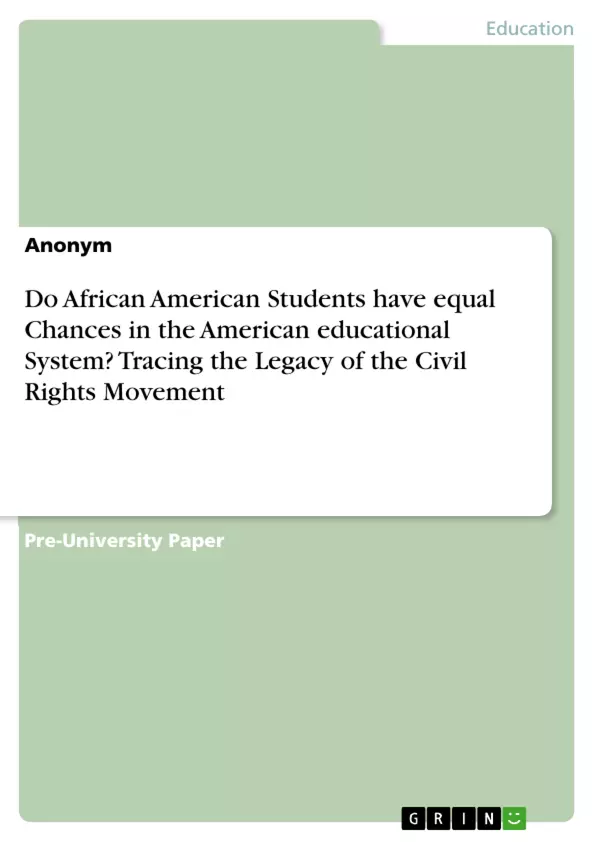Tracing the legacy of the Civil Rights Movement in the American educational system - equal chances for African American students? For a general understanding of why the question if African American students have the same chances as everyone else is even relevant, I started my research paper with the historic background, including the situation before the Civil Rights Movement and what changed afterward, especially concentrating on the major court case “Brown v. Board of Education”, which made separation in public facilities unconstitutional. So if after the movement everyone is supposed to get treated equally under the law, it may be easy to assume that African Americans must have the same opportunities, but unfortunately, it is not that easy. Several studies try to find out whether segregation of school districts, higher education barriers, poverty rates and so on really affect the education of black students, leading me to also analyze their influences on the final question, if the educational system provides African Americans with the same opportunities as privileged white students. After explaining the current situation and researching further studies, I therefore conclude if black students have the same chances or not. Finally, I am going to give examples of the most important changes required to solve the problems black students are confronted with today, to assure that everyone has an equal start in life, preventing further racial discrimination and hurdles of African Americans, which often root in an unequal start early in life. Lastly, it was particularly challenging to lower down the different aspects you need to consider to decide if African American students have equal chances, due to all the different factors that impact whether you academically succeed or not.
Inhaltsverzeichnis (Table of Contents)
- Introduction
- The situation of African American students before and the achievements of the Civil Rights Movement
- The separate but equal doctrine
- Influences of the Brown vs. Board of Education Supreme Court case of 1954
- The affect of the Civil Rights Act of 1964 on the education of African American students
- Having one foot in each world, but still being alienated from both
- Today's conditions in schools for African American students
- Reasons for the achievement of racial equality in schools
- Segregation of school districts
- African American student's perception of higher education barriers
- Are there equal chances for African American students?
- How to solve the problems?
- Resource Equalization
- Raising standards for teachers
- Addressing the school-to-prison pipeline
- Conclusion
Zielsetzung und Themenschwerpunkte (Objectives and Key Themes)
This paper examines the legacy of the Civil Rights Movement in the American educational system, exploring whether African American students have equal opportunities compared to their white counterparts. The main objective is to investigate the historical and current conditions affecting the educational experiences of African American students, focusing on the impact of segregation, access to resources, and perceptions of higher education barriers.
- The impact of the Civil Rights Movement on the education of African American students
- The continuing challenges faced by African American students in the American educational system
- The role of segregation and resource inequality in shaping educational outcomes
- The impact of African American students' perceptions of higher education barriers
- Potential solutions to address disparities in the educational system
Zusammenfassung der Kapitel (Chapter Summaries)
The paper begins by introducing the historical context of racial discrimination against African Americans in the United States, particularly within the educational system. The chapter examines the impact of the "separate but equal" doctrine, highlighting the disadvantages faced by African American students under this system.
The following chapter delves into the pivotal Supreme Court case of Brown v. Board of Education, exploring its significance in challenging the legal basis for school segregation. The chapter further investigates the influence of the Civil Rights Act of 1964 on the education of African American students, assessing its impact on promoting equality in access to education.
The paper then examines the current conditions in schools for African American students, analyzing the reasons for the perceived achievement of racial equality and discussing the ongoing challenges of school segregation and disparities in resources. The chapter also delves into the perception of higher education barriers among African American students, exploring factors that contribute to these perceptions.
Schlüsselwörter (Keywords)
The key themes and concepts explored in this paper include the Civil Rights Movement, educational disparities, racial equality, school segregation, resource inequality, access to higher education, African American students, and educational opportunities.
- Quote paper
- Anonym (Author), 2022, Do African American Students have equal Chances in the American educational System? Tracing the Legacy of the Civil Rights Movement, Munich, GRIN Verlag, https://www.grin.com/document/1265522



